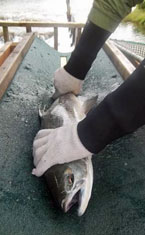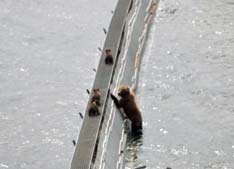Leif Korth, College Intern I
Commercial Fisheries - Kodiak

After arriving to Kodiak and spending a night in the Fish and Game bunkhouse, I received training at the office for boating and bear safety. Both of which are essential to understand for life in a Kodiak field camp.
On my second full day in Kodiak, I was sent out to my first field camp of the season. I was headed to Afognak Island to work on the weir downstream of Afognak Lake.
Having spent my last two summers working in a field camp and living out of a tent*, I was pleasantly surprised by the accommodations at Litnik. I had a whole cabin to myself! There was also a main cabin housing my co-workers, along with a banya and garden.

One of the primary jobs at Litnik was sampling a subset of the sockeye salmon smolt outmigration. Each day we would take length, weight, and scale samples for 10% (or a minimum of 5 smolt) of the total smolt we caught with the in-stream fan trap.
In order to determine the catch efficiency of the fan trap we sampled from, we conducted several dye-releases upstream. These smolt were caught in a secondary upstream fan trap, and were dyed using a bismark brown solution. Every fish dyed and released was recorded in order to determine the downstream trap efficiency. The goal was to catch approximately 15% of the total smolt outmigration.
We worked at Afognak lake several different times catching sockeye smolt during their residency in the lake. We used a beach seine at 5 different near-shore sites to collect smolt. Since smolt reside near-shore during crepuscular periods, this led to late nights anytime we worked at the lake. Smolt that were caught in the beach seines were also sampled for length, weight, and scales.

The weir in Afognak River was used to determine the adult escapement (number of adults returning upstream) for the season. Each fish passing though the weir was counted as they passed through the weir gate and over a flash-panel used to identify species.
Like smolts, we also sampled a subset of the returning adults. For every adult sampled we recorded length, sex, and took a scale sample so that age could be determined back at the lab.
I went to work at my second field camp of the season in early July. Frazer Fish Pass is located on the opposite end of Kodiak Island from Afognak. The fish pass was put in so that salmon could navigate upstream of a waterfall that was the former barrier to anadromy and use Frazer lake for spawning and rearing habitat.
Like Afognak, each fish returning through the weir is counted. The fish are funneled into the fish pass which deliver the fish into a holding tank at the top of the falls. Each week we sampled 240 total sockeye, taking scales, length, and sex.

At Frazer, bears were a part of everyday life. The weir blocks a lot of fish at one time, making it the perfect place for bears to find an easy food source. Tourists groups came on nearly a daily basis to view the bears behind the weir. While at first the high abundance and relatively close proximity to so many bears was a little intimidating, it soon became just another part of life in the field.
While at both field camps there was plenty of time for some non-work related activities. Summer solstice was celebrated by a hike to the top of one of the mountains surrounding Afognak Lake. Another time, we caught a ride down to the Dog-Salmon weir to spend time with the crew down there, as well drop some pots for King crab then hiked 7 miles back to Frazer with backpacks full of crab!
As a fisheries biology major at Humboldt State University, the experiences I gained during my internship tied directly into my field of study. Getting hands on experience with fisheries techniques that I have learned over the past few years can't be beat. Interning with Alaska Fish & Game has helped to affirm my resolve for pursuing higher education in fisheries, along with showing me what Alaska has to offer.
* Leif was a College Intern II with the Division of Sport Fish in 2011 and 2012 working out of our Palmer office.
